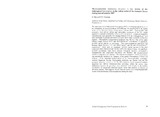Abstract:
The importance of the Subtropical Convergence (STC) as a biogeographical barrier to the distribution of mesozooplankton (200-2000µm) was investigated in the Indian sector of the Southern Ocean during austral autumn 2007. Hydrographic data revealed a well defined surface and sub-surface expression of the STC which appeared to meander considerably between 41°S and 41°15'S. Surface chlorophyll-a concentrations were generally low ranging between 0.08 and 0.68mgChl-a.m-3 and were dominated by picophytoplankton (<0.2µm) which made up 68.6% of the total pigment. Chlorophyll-a concentrations integrated over the top 150m of the water column ranged between 11.97 and 40.07mgChl-a.m-2 and showed no significant (p>0.05) spatial patterns in distribution. Total mesozooplankton abundance and biomass ranged between 13.1 and 1028.4 ind.m· 3 and 0.8 and 23.l mg.Dwt.m-3 respectively. There were no significant (p>0.05) spatial patterns in the total mesozooplankton abundance and biomass within the region of study. No significant (p>0.05) correlations were found between biological variables (chlorophyll-a concentrations and zooplankton abundance and biomass) and physiochemical variables (temperature and salinity). The total mesozooplankton community structure was numerically dominated by copepods of the genera Pluromamma, Ca/anus and Oithona. Other important representatives of the mesozooplankton community included Euphausia furcilia, Chaetognaths (Eukronia and Sagitta spp) and the pteropod, Limacina retroversa. At the 40% similarity level, numerical analysis identified five distinct mesozooplankton groupings within the survey area. Differences between the groupings were associated with changes in the relative contribution of numerically dominant species rather than presence or absence of individual species. This suggests that the front did not act as a strong biogeographic barrier to the distribution of mesozooplankton during the study.

